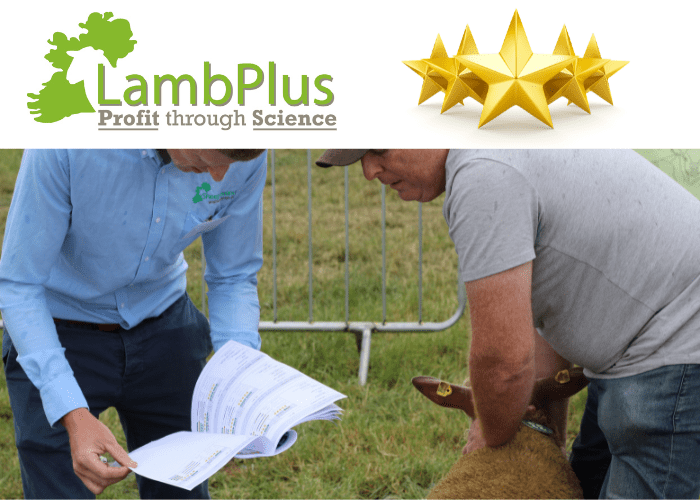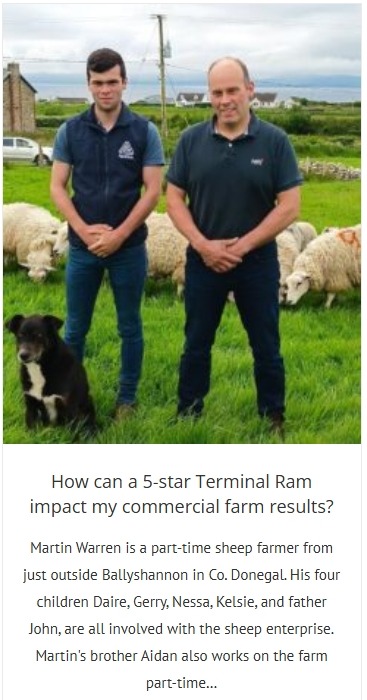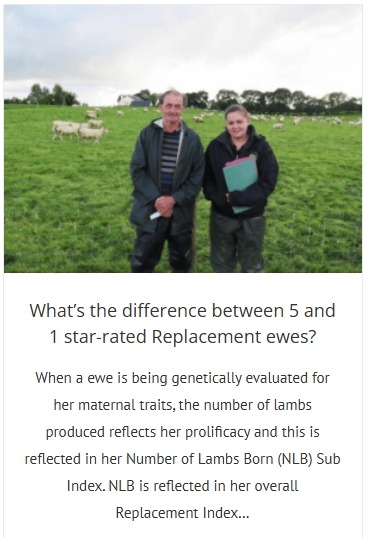Thinking of buying a 5-Star ram? Do €urostars work for commercial farmers?
Yes.
Data used in the €uroStar evaluations also comes from commercial grass-based sheep flocks, which means that a lot of the data included in the €uroStar indexes is independently collected by Sheep Ireland field technicians or from commercial flocks involved in various Sheep Ireland or Teagasc programs.
So, how can a 5-star Ram impact my farm results?
Read more about it in these commercial case studies (click) and check the research data below:
How can a 5-star Terminal Ram impact my commercial farm results? – Sheep Ireland
What’s the difference between 5 and 1 star-rated Replacement ewes? – Sheep Ireland
Research data:
Some of these programs include the Sheep Ireland Central Progeny Test (CPT), the Teagasc BETTER Farm programme and OviData participating flocks, Teagasc sheep research flocks, and Independent commercial flocks involved in LambPlus.
These flocks use pedigree €uroStar rams for mating with their ewes, and all the data collected on the subsequent lambs born contribute to the €uroStar evaluations published for Irish sheep farmers.
Lambs are weighed regularly on the CPT and Teagasc BETTER Farm flocks, and this allows the evaluation to compare the performance of different bloodlines and €uroStar-rated rams.
The results show that progeny from 5-Star rams are outperforming their 1-Star counterparts throughout their lifetime.
Using the 40-day weight as an example, lambs sired by 5-Star Terminal rams are weighing on average 1.0kg heavier than their 1-Star equivalents. This trend continues up until the animals are 150 days old, where again, the lambs sired by 5-Star Terminal rams, weigh on average 2.2kg heavier than the 1-Star lambs.
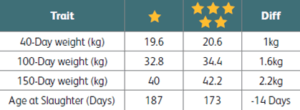
These lambs are followed right through to slaughter, and our data also shows that lambs sired by 5-Star Terminal rams were slaughtered 14 days sooner than lambs sired by 1-Star rams in these commercial flocks.
In Summary, selecting 5-Star rams on the Terminal Index to breed lambs destined for slaughter results in increased lamb weight gain, and progeny reaching slaughter at a younger age.
In Figure 1, the results show that using 5-Star Terminal Rams reduces lambs age at slaughter by 14 days compared to 1-Star Rams.
To assess the usefulness of the genetic indexes in detecting differences in performance between animals performance data across a range of key areas including lambing, lamb performance, ewe performance & health traits (dagginess) recorded between 2017 and 2021 were extracted from the Sheep Ireland database; the data consisted of both crossbred (28%) and purebred (72%) animals. The number of records available differed per trait but varied from 105,248 to 37,587 records. To quantify the accuracy of the Irish maternal genetic evaluations for improving maternal traits in the national flock, individual animal breeding values for maternal traits were compared to performance on farm for the same trait.
In Figure 2, results show that 5 star ewes across a range of maternal traits had a greater reproductive performance on farm. Ewes with a 5 star rating for fertility (i.e. the number of lambs born breeding value) produced, on average, an additional 0.38 lambs per lambing compared to a ewe of 1 star for the number of lambs born breeding value.
Although 5 star ewes produced a 0.23 kg heavier lamb at birth, 5 star ewes had experienced lower levels of lambing difficulty (10% less lamb dystocia) compared to ewes of 1 star for the relevant trait. Lower lamb mortality was also associated with ewes of 5 star rating for lamb survival, on average, 5% more lambs survived at lambing compared to 1 star ewes.
Greater growth rates were also seen with lambs born to 5 star ewes both at pre-weaning and weaning with lambs born to 5 star ewes 0.64 kg and 1.62 kg heavier at pre-weaning and weaning compared to lambs born to 1 star ewes, respectively. Animals with 5 star rating also had a lower dag score (0.56 score) compared to animals with a 1 star rating.
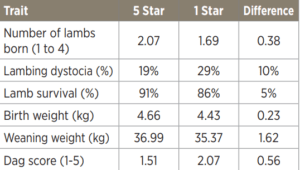
Results from this research indicate that selection of breeding animals for favorable maternal genetic attributes will result in favorable improvements in performance and profitability at farm level. Genetic evaluations are an important tool for sheep farmers to make more informed breeding decisions for increasing farm profitability.

